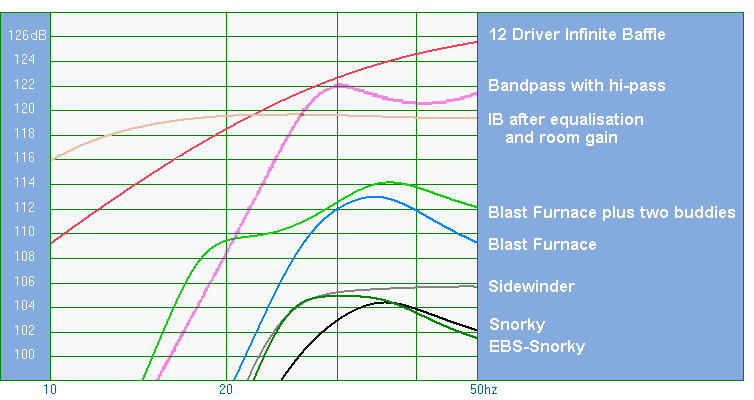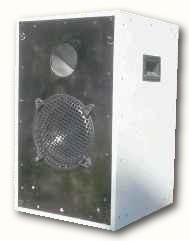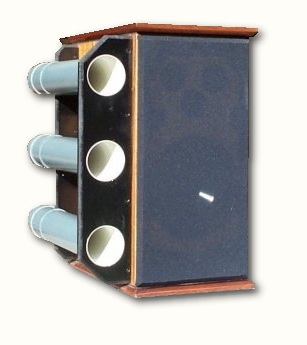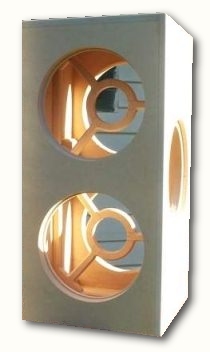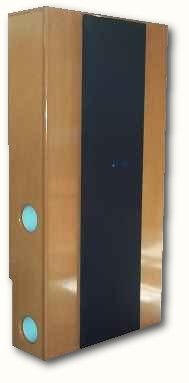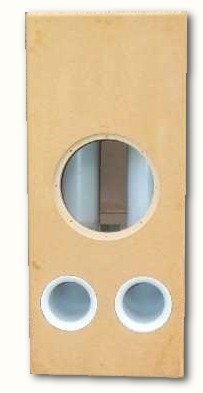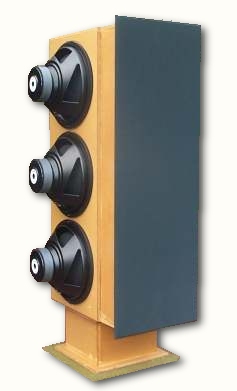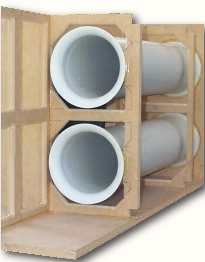The Projects
This section lists nine subwoofers built over several years. They were all designed using WinISD,
which allowed different drivers and port arrangements to be explored.
See the WinISD page for more information on obtaining and using WinISD.
Each project page generally includes the following graphs and screenshots....
Peak SPL
The SPL graphs give a fairly good indication of what would be measured in-room at one metre
The WinISD values are for radiation into "Half space". In reality, most subs will be located near a wall (add 3dB)
or in a corner (add 6dB). Room gain can add around 6dB@10hz, 4dB@20hz and 2dB@40hz.
These gains are more or less canceled by the fact that the typical signal fed to the sub will be a complex waveform
rather than a sine wave which results in up to 12dB less output.
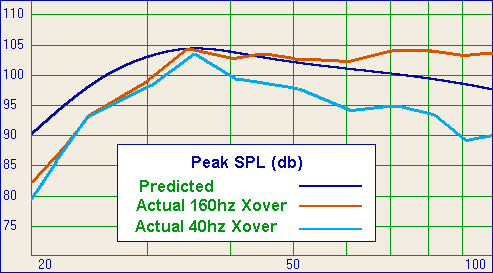
Cone excursion
With a ported design, cone excursion below the working range of the port can become a problem.
This will be audible and ultimately destructive to the speaker.
See the Active High-Pass filter page for some insurance against such a disater.
Includes circuit and construction details.
All designs keep excursion to Xmax + 10%

Port velocity
Keeping an eye on airspeed when designing is most important because if the air is too fast, turbulence will be audible.
Using a larger diameter port will cut the speed, but the length increases with the area of the port.
Opinions vary as to an acceptable maximum for velocity. WinISD recommends 17 metres/sec, but I found that
I could still hear some turbulence on the peaks when using unflared ports. Dropping the speed to 10m/s fixed the problem.
The degree of flaring on the end of the ports can have an influence on noise.
I finish the ports in the "Snorky" and "Slim Jim" projects with a 10mm radius rollover bit in the router
and stay with a 10m/s limit.
I've recently completed some flare testing where diy flares of different
sizes were measured to find how much the speed can be lifted before turbulence becomes audible.
The results of these tests have been encapsulated in the 'Flare-it' calculator shown next.
The "EBS-Snorky design" has flared ports based designed with this calculator. Redesigned flares were also retrofitted
to the "Buddy subs". The bandpass sub, listed later on this page, uses 6-inch ports with 30mm flares and can handle 21 m/sec airspeed without problems.
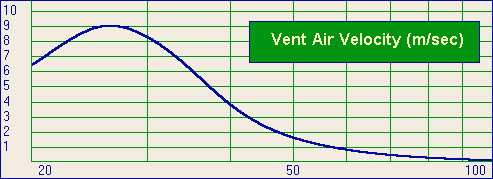
Flare-it screenshots
The flare testing mentioned above, culminated in the writing of the Flare-it calculator. Each project has a screenshot showing how well the port flares perform. In most cases this analysis has been done after the sub has been built. Where "chuffing" is predicted, a second screenshot shows what sized flares would be required to fix the problem
The grey line shows the predicted port velocities.
The blue line shows the velocities you can use before boundary layer turbulence occurs (ie chuffing).
The red line shows the velocities you can use before core turbulence and compression occurs.
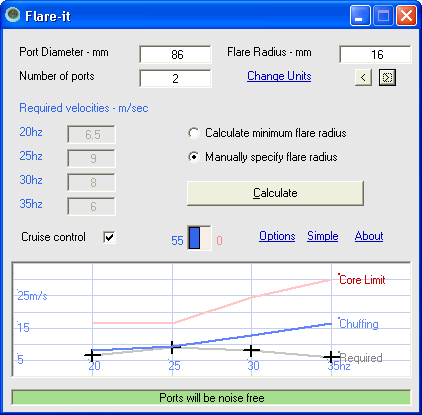
Here they are ...
The Beer Fridge
About the same size and shape as a beer fridge, the subwoofer worked well enough for a first effort at DIY. I was enthusiastic at the time, but looking back I see it was just a box with a hole and no soul, much better was to come!- 80W Single 10" driver
- 105dB Peak SPL
The Sidewinder
- Ported sub design: This is a ported subwoofer, which has a tunnel or a port that allows air to flow in and out of the box. This helps the subwoofer produce lower frequencies and more bass.
- Large diameter ports: Ported subs need large ports to reduce air turbulence and noise. However, large ports also mean longer ports, which are harder to fit inside the box.
- External ports: To solve this problem the ports were run externally, meaning they wrap around the side of the box instead of being inside. This also gives the subwoofer a unique and attractive look.
- Veneered finish: The sub was finished with a veneer, which is a thin layer of wood added to the box. This gives the subwoofer a more natural and elegant appearance.
- 125W Single 10" driver
- 106dB Peak SPL
The Blast Furnace
So called because the twin chamber, dual ports looked a bit like one. My third subwoofer gives plenty of grunt down to 25hz. With this one I decided to dispense with the veneering and make the most of the MDF. With three coats of polyurethane it acquires a honey colour which can be quite attractive. Includes construction gallery and graph of measured response along with a comparison with commercially available THX rated subs- This is more like it!
- Louder and bigger
- 240W Dual 10" drivers
- 113dB Peak SPL
Snorky
The name arises from the internal ports, which are folded into a snorkel shape. This is basically a "Beer Fridge" clone in terms of output, but smaller, with a better build and finish, and no port noise complaints- Better finish
- More compact
- 80W 10" driver
- 105dB Peak SPL
Buddy Subs
A pair of "Buddy" subs which run in parallel with the "Blast Furnace" This gives extension to 17hz without loss of Peak output- 10" driver
- Port tune 19hz
- 110 litre
- Allows the full 350w to be extracted from the Jaycar amp
Slim Jim
Limited space dictated a slim design for this one. The internals of the original "Beer Fridge" were recycled to come up with "Slim Jim"- Side firing ports
- 80W Single 10" driver
- 105dB Peak SPL
EBS-Snorky
A chance came to try an EBS design (Extended Bass Shelf). This sub uses the same amp and driver as the "Snorky" design, and has a pair of 20mm heat molded flares which are fitted with donut rings on the intakes- 80w single 10" driver
- Tuning frequency 26hz
- 100 litre
- Extension to 24hz
- 105dB peak SPL
Infinite Baffle
The loudest creation is an Infinite Baffle sub. It contains twelve 15inch drivers on two manifolds. The design is the IB12 investigated on the 15inch Venom driver page- 12 drivers
- Behringer EP2500 amp
- 670w normal Duty
- 1700w at Xlim
- 118dB @ 20hz (normal duty)
6th-Order Bandpass
The most recent subwoofer is a parallel tuned 6th-order bandpass sub- 18 inch IXL-18.2.2 driver
- 200 litre / 25hz plus 60 litrs / 53hz
- Three 6-inch ports
- Design power 1000w (de-rated to 600w without a highpass filter)
- 122dB from 30hz to 60hz (de-rated to 120dB without a highpass filter)
- -3dB point 26hz to 73hz
Performance Comparison
